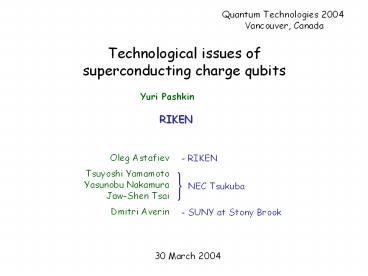Technological issues of - PowerPoint PPT Presentation
1 / 20
Title:
Technological issues of
Description:
Technological issues of. superconducting charge qubits. Oleg Astafiev ... SUNY at Stony Brook. Yuri Pashkin. RIKEN. 30 March 2004. Quantum Technologies 2004 ... – PowerPoint PPT presentation
Number of Views:33
Avg rating:3.0/5.0
Title: Technological issues of
1
Quantum Technologies 2004 Vancouver, Canada
Technological issues of superconducting charge
qubits
Yuri Pashkin
RIKEN
Oleg Astafiev Tsuyoshi Yamamoto Yasunobu
Nakamura Jaw-Shen Tsai Dmitri Averin
- RIKEN
- SUNY at Stony Brook
30 March 2004
2
Outline
- introduction
- electrostatic coupling
- single-shot readout
- T1 and T2 measurement
- technological issues
3
Cooper-pair box
M. Büttiker, 1987 V. Bouchiat et al, 1995
- a single artificial two-level system
- 108 conduction electrons in the box
E (CgVg 2ne)2/2C
box
reservoir
Cooper-pair tunneling
- - - -
n0
1
gate
4
Charge qubit based on Cooper-pair box
Y. Nakamura et al, 1999
eigenstates
energy
EJ
gate voltage
initialization coherent superposition read-out
final state
5
Final state read-out
Josephson-quasiparticle cycle (Fulton et
al., 1989)
2e
Cooper-pair box
- detect the state
- initialize the system to
6
Capacitively coupled charge qubits
standard e-beam lithography angle evaporation
I1 and I2 give info on charge states
7
Hamiltonian
charge basis
EJ1,2 Em lt Ec1,2
initial state
I00gt
Ec1, Ec2, Em EJ1, EJ2
En1n2 Ec1(ng1n1)² Ec2(ng2n2)²
Em(ng1n1)(ng2n2) Ec1,2 4e²CS2,1/2(CS1,2CS2,1
Cm²) ? 4e²CS2,1/2CS1,2CS2,1 ng1,2 (Cg1,2Vg1,2
CpVp)/2e Em 4e²Cm/(CS1CS2 Cm2)
8
Oscillations at the double degeneracy
E00 E11
E10 E01
0,0
I2
I1
1,0
dc gate1
0,1
dc gate2
1,1
pulse gate
ng1 ( ng2)
ng2
time
1,1
1
0,1
0.5
X
superposition of four charge states!
0
1,0
0,0
ng1
1
0.5
0
9
Quantum beatings
? - ?
? - ?
? ?
? ?
2?
2?
operation point
ng1 ( ng2)
0.5
0.45
2?f
10
Quantum beatings experiment
EJ1
ng2
1,1
1
0,1
X
EJ2
0.5
L
R
0
1,0
0,0
ng1
1
0.5
0
? - ?
? ?
theoretically expected EJ1 13.4 GHz EJ2 9.1
GHz Em 15.7 GHz
11
Single-shot readout
EJ
EJ
trapSET readout
conventional readout
?qp 0
?qp 1/10 ns
?
?
?
?
trap kept unbiased during coherent evolution ? no
qp relaxation!
2(? Ec)
reservoir
reservoir
probe permanently biased !
box
box
12
Trap SET readout
box trap galvanically isolated from the leads !
no qp relaxation ! no effect of the leads !
13
Time trace
14
Single-shot readout coherent oscillations
dead zones
degeneracy
15
Relaxation of coherent oscillations
no increase in T2
16
T1 measurement
E
- create 1 state by NA ?-pulse
- move slowly along the upper band
- stay for time ?
- move slowly back
- repeat for different ?
ng
?-pulse
?
with probability exp(-?/T1)
time
17
T1 measurement experiment
18
Superconducting charge qubits
control
substrate
T1
T2
group
readout
dc probe
NEC
pulse
SiNx
5 ns
5 ns
pulse probe
trapSET
switching current
1.8 ?s
0.5 ?s
SiO2
?-waves
Saclay
1 ?s
SiNx
100 ns
pulse
SiO2
Chalmers
5 ns
5 ns
RF-SET
19
What next?
1. Qubit readout dc probe ? pulsed probe
trap SET 2. Qubit control NA pulses
? ?-waves 3. Materials qubit Al ?
Nb? substrate SiNx ? SiO2 4. Dependence of T1
and T2 on (1-3)
20
Nb SET
Nb lead
Nb island
AlOx Barrier































